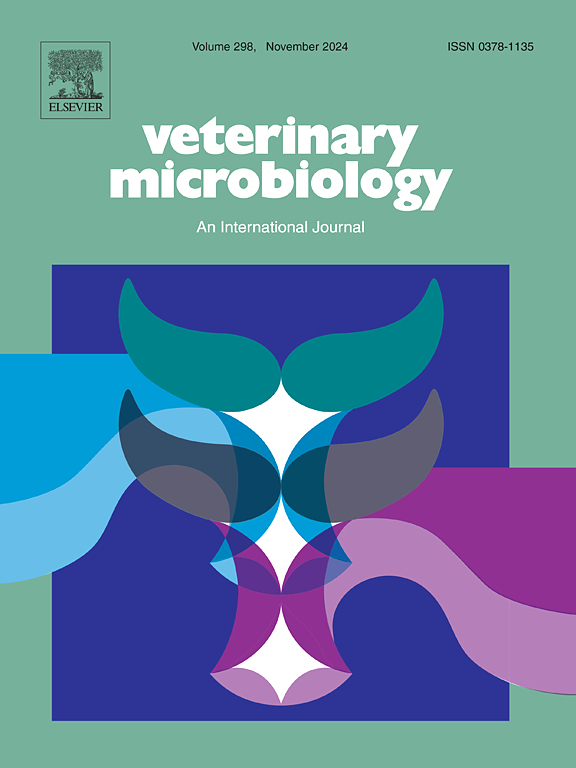母亲接种疫苗部分保护仔猪免受甲型流感病毒相关的微生物组和海马基因表达的改变
IF 2.7
2区 农林科学
Q3 MICROBIOLOGY
引用次数: 0
摘要
甲型流感病毒(IAV)在多种鸟类和哺乳动物宿主(包括人类和猪)中引起呼吸道疾病,并伴有全身性并发症。在新生儿中感染IAV可能特别具有破坏性,因为已知病毒感染会破坏这一时期发生的快速发育过程。母亲接种IAV疫苗可以降低婴儿感染IAV的风险,但目前尚不清楚抗IAV抗体的被动转移是否能预防感染的下游并发症。在这项研究中,我们评估了母亲接种疫苗对感染甲型流感病毒的新生仔猪肠道和鼻腔微生物群发育以及海马转录组的影响。母猪要么在妊娠70天和90天接种实验性甲型流感疫苗,要么接种PBS模拟疫苗。由接种疫苗和未接种疫苗的母猪所生的新生仔猪在分娩后6天用致病性IAV分离物或PBS模拟攻毒,并在攻毒后5天安乐死。接种疫苗可显著减少仔猪肺部病变和传染性病毒载量。与未接种疫苗的母亲感染病毒的动物相比,感染病毒的动物与感染前时间点的偏差增加,这表明鼻腔和肠道微生物群落的发育也部分受到了病毒破坏的保护。海马组织的大量RNA测序鉴定出1146个差异表达基因(FDR <;0.05)。来自接种疫苗母猪的iav感染仔猪显示出与病毒免疫应答相关的基因增加,而来自未接种疫苗母猪的iav感染仔猪显示出与神经发生相关的基因增加和与血管发育相关的基因减少。许多这些差异调节基因与微生物群落丰度密切相关,表明微生物群可能与IAV结果有关。值得注意的是,鼻腔微生物丰度与海马基因表达模式有着复杂的联系,这表明在发育早期,鼻腔微生物群-大脑通讯轴很强。总之,我们的研究结果表明,母亲接种疫苗可以部分保护新生仔猪免受流感病毒感染,并减轻IAV感染对微生物组和认知的潜在长期影响。本文章由计算机程序翻译,如有差异,请以英文原文为准。
Maternal vaccination partially protects piglets against influenza A virus associated alteration of the microbiome and hippocampal gene expression
Influenza A virus (IAV) causes respiratory disease with systemic complications in a variety of avian and mammalian hosts, including humans and pigs. Infection with IAV in newborns can be particularly damaging as viral infection is known to disrupt the rapid developmental processes that occur during this period. Maternal IAV vaccination can reduce the risk of IAV infection in infants, but it is unknown whether passive transfer of anti-IAV antibodies protect against the downstream complications of infection. In this study, we evaluated the impact of maternal vaccination on the gut and nasal microbiota development and hippocampal transcriptome in neonatal piglets infected with influenza A virus. Sows were either vaccinated with an experimental influenza A vaccine at 70- and 90-days gestation, or mock-vaccinated with PBS. Neonatal piglets born from vaccinated and unvaccinated sows were challenged with a pathogenic IAV isolate or mock-challenged with PBS at 6 days post-farrowing and euthanized five days post challenge. Vaccination significantly reduced lung lesions and infectious viral load in piglets. Nasal and gut microbial community development was also partially protected from viral disruption as indicated by increased deviation from pre-challenge timepoints compared to animals challenged with the virus from unvaccinated mothers. Bulk RNA sequencing of hippocampal tissue identified 1146 differentially expressed genes (FDR < 0.05) between groups. IAV-infected piglets from vaccinated sows showed increases in genes related to viral immune responses, while IAV-infected piglets from unvaccinated sows showed increases in genes related to neurogenesis and decreases in genes related to vascular development. Many of these differentially regulated genes were strongly correlated with microbial community abundances, indicating that the microbiota may contribute to IAV outcomes. Notably, nasal microbial abundances intricately connected with hippocampal gene expression patterns, suggesting a strong nasal microbiome-brain communication axis in early development. Together, our results indicate that maternal vaccination partially protects neonatal piglets against influenza virus infection and mitigates the potential long-term impacts of IAV infection on the microbiome and cognition.
求助全文
通过发布文献求助,成功后即可免费获取论文全文。
去求助
来源期刊

Veterinary microbiology
农林科学-兽医学
CiteScore
5.90
自引率
6.10%
发文量
221
审稿时长
52 days
期刊介绍:
Veterinary Microbiology is concerned with microbial (bacterial, fungal, viral) diseases of domesticated vertebrate animals (livestock, companion animals, fur-bearing animals, game, poultry, fish) that supply food, other useful products or companionship. In addition, Microbial diseases of wild animals living in captivity, or as members of the feral fauna will also be considered if the infections are of interest because of their interrelation with humans (zoonoses) and/or domestic animals. Studies of antimicrobial resistance are also included, provided that the results represent a substantial advance in knowledge. Authors are strongly encouraged to read - prior to submission - the Editorials (''Scope or cope'' and ''Scope or cope II'') published previously in the journal. The Editors reserve the right to suggest submission to another journal for those papers which they feel would be more appropriate for consideration by that journal.
Original research papers of high quality and novelty on aspects of control, host response, molecular biology, pathogenesis, prevention, and treatment of microbial diseases of animals are published. Papers dealing primarily with immunology, epidemiology, molecular biology and antiviral or microbial agents will only be considered if they demonstrate a clear impact on a disease. Papers focusing solely on diagnostic techniques (such as another PCR protocol or ELISA) will not be published - focus should be on a microorganism and not on a particular technique. Papers only reporting microbial sequences, transcriptomics data, or proteomics data will not be considered unless the results represent a substantial advance in knowledge.
Drug trial papers will be considered if they have general application or significance. Papers on the identification of microorganisms will also be considered, but detailed taxonomic studies do not fall within the scope of the journal. Case reports will not be published, unless they have general application or contain novel aspects. Papers of geographically limited interest, which repeat what had been established elsewhere will not be considered. The readership of the journal is global.
 求助内容:
求助内容: 应助结果提醒方式:
应助结果提醒方式:


